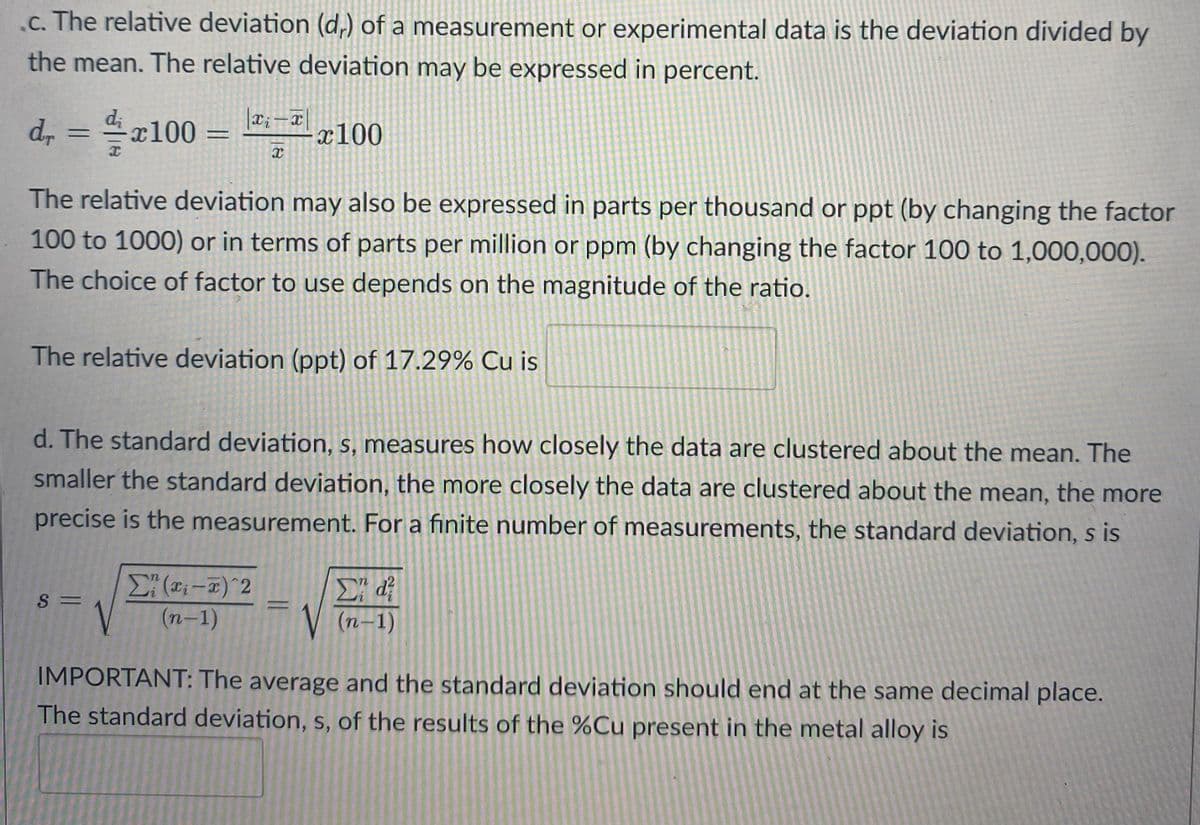.c. The relative deviation (d,) of a measurement or experimental data is the deviation divided by the mean. The relative deviation may be expressed in percent. d, = r100 = |x;-x -x100 The relative deviation may also be expressed in parts per thousand or ppt (by changing the factor 100 to 1000) or in terms of parts per million or ppm (by changing the factor 100 to 1,000,000). The choice of factor to use depends on the magnitude of the ratio. The relative deviation (ppt) of 17.29% Cu is d. The standard deviation, s, measures how closely the data are clustered about the mean. The smaller the standard deviation, the more closely the data are clustered about the mean, the more precise is the measurement. For a finite number of measurements, the standard deviation, s is " d? S = || (n-1) (n-1) IMPORTANT: The average and the standard deviation should end at the same decimal place. The standard deviation, s, of the results of the %Cu present in the metal alloy is
.c. The relative deviation (d,) of a measurement or experimental data is the deviation divided by the mean. The relative deviation may be expressed in percent. d, = r100 = |x;-x -x100 The relative deviation may also be expressed in parts per thousand or ppt (by changing the factor 100 to 1000) or in terms of parts per million or ppm (by changing the factor 100 to 1,000,000). The choice of factor to use depends on the magnitude of the ratio. The relative deviation (ppt) of 17.29% Cu is d. The standard deviation, s, measures how closely the data are clustered about the mean. The smaller the standard deviation, the more closely the data are clustered about the mean, the more precise is the measurement. For a finite number of measurements, the standard deviation, s is " d? S = || (n-1) (n-1) IMPORTANT: The average and the standard deviation should end at the same decimal place. The standard deviation, s, of the results of the %Cu present in the metal alloy is
Chapter4: Least-squares And Calibration Methods
Section: Chapter Questions
Problem 4P
Related questions
Question
The results of the analysis of a metal alloy were reported in terms of percent Cu (%Cu). The values obtained are 17.34%, 17.33%, 17.28%, 17.29%, 17.36%.

Transcribed Image Text:.c. The relative deviation (d,) of a measurement or experimental data is the deviation divided by
the mean. The relative deviation may be expressed in percent.
d, = 4x100 =
|x;-x
x100
%3D
The relative deviation may also be expressed in parts per thousand or ppt (by changing the factor
100 to 1000) or in terms of parts per million or ppm (by changing the factor 100 to 1,000,000).
The choice of factor to use depends on the magnitude of the ratio.
The relative deviation (ppt) of 17.29% Cu is
d. The standard deviation, s, measures how closely the data are clustered about the mean. The
smaller the standard deviation, the more closely the data are clustered about the mean, the more
precise is the measurement. For a finite number of measurements, the standard deviation, s is
Σ
S =
(n-1)
V
(n–1)
IMPORTANT: The average and the standard deviation should end at the same decimal place.
The standard deviation, s, of the results of the %Cu present in the metal alloy is
Expert Solution
This question has been solved!
Explore an expertly crafted, step-by-step solution for a thorough understanding of key concepts.
This is a popular solution!
Trending now
This is a popular solution!
Step by step
Solved in 3 steps

Knowledge Booster
Learn more about
Need a deep-dive on the concept behind this application? Look no further. Learn more about this topic, chemistry and related others by exploring similar questions and additional content below.Recommended textbooks for you


Chemistry & Chemical Reactivity
Chemistry
ISBN:
9781133949640
Author:
John C. Kotz, Paul M. Treichel, John Townsend, David Treichel
Publisher:
Cengage Learning

Principles of Instrumental Analysis
Chemistry
ISBN:
9781305577213
Author:
Douglas A. Skoog, F. James Holler, Stanley R. Crouch
Publisher:
Cengage Learning


Chemistry & Chemical Reactivity
Chemistry
ISBN:
9781133949640
Author:
John C. Kotz, Paul M. Treichel, John Townsend, David Treichel
Publisher:
Cengage Learning

Principles of Instrumental Analysis
Chemistry
ISBN:
9781305577213
Author:
Douglas A. Skoog, F. James Holler, Stanley R. Crouch
Publisher:
Cengage Learning

Principles of Modern Chemistry
Chemistry
ISBN:
9781305079113
Author:
David W. Oxtoby, H. Pat Gillis, Laurie J. Butler
Publisher:
Cengage Learning
